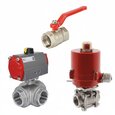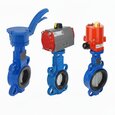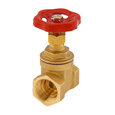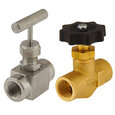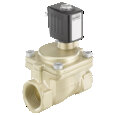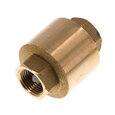Valve Sizing Calculator
The size of a valve can refer to the physical dimensions of the valve, such as its opening diameter, but also the flow rate the valve is capable of. Ensuring that the valve flow coefficient is calculated and measured correctly will ensure that the media can flow at the desired pressure. To calculate the flow rate through a valve, parameters such as pressure drop, fluid density, and flow rate must be determined. This article will focus on the practical methods for calculating each parameter, providing a comprehensive guide to valve coefficient calculations.
Kv and Cv calculator
Use our calculators in our Kv and Cv articles. Flow calculators make it simple to calculate the Kv or Cv a valve should have to ensure it fits the system's requirements. The user must input the following information to get the Kv or Cv value:
- Media
- Inlet pressure
- Outlet pressure
- Flow rate
View our online selection of valves!
What is valve flow coefficient
The valve flow coefficient measures the rate at which fluid (liquid or gas) can pass through a valve. Determining the correct flow coefficient value helps select the right-sized valve for an application, ensuring that all fluids can flow through at the desired pressure. An incorrect flow coefficient can result in poor valve performance and lead to leaks, inconsistent flow, cavitation, and inability to open or close completely. The Cv and Kv values are the flow coefficients in the imperial and metric systems, respectively.
The parameters required for flow rate calculation are:
- Q: Desired flow rate
- dp: Pressure differential
- SG: Specific gravity
The expressions for Kv and Cv are different for liquids and gasses. This is because the physical properties and behavior of liquids and gasses are different.
- Liquids are nearly incompressible, while gasses are highly compressible. The pressure drop across a pipe carrying a liquid is different from that of a gas due to the difference in compressibility.
- Liquids have a higher viscosity than gasses, which affects their flow rate.
Once the flow coefficient is calculated, it is recommended to choose a valve with a flow coefficient slightly higher than the calculated value to ensure that the desired flow rate is achieved and to provide a safety margin for potential changes in pressure or flow rate. In some cases, the valve is predetermined, and you can calculate the flow rate suitable for that valve by working the formula backward due to the known Cv/Kv value. The following sections discuss how to estimate each parameter for flow coefficient calculation.
Flow coefficient Cv
The Cv value is the flow rate of water in U.S. gallons per minute (GPM) at a temperature of 60 𐩑F with a pressure drop of 1 psi across the valve. For example, a valve with a Cv of 10 will pass 10 GPM of fluid at 60 𐩑F and 1 psi pressure drop across the valve. The Cv value is listed in the valve’s product description or specifications label.
Flow coefficient Kv
Kv is the volume of water in cubic meters that flows through a valve per hour at a pressure drop of 1 bar with a fully open valve. For example, a Kv of 20 means that the valve has a flow capacity of 20 cubic meters per hour (m³/h) when there is a pressure drop of 1 bar across the valve. The Kv value is listed in the valve’s product description or specifications label.
Flow rate
The flow rate is given by:
- Q: Flow rate
- A: The cross-sectional area at a point in the path of the flow
- v: Fluid velocity at the point
There are multiple ways to measure the flow rate of a system. To calculate the flow rate through an orifice (like a valve port or spigot), allow a specific volume to accumulate in a container and measure how long it takes. For example, the flow rate from a spigot can be measured by allowing the fluid to fill a 7-gallon bucket and recording the time. Divide 7 by the time taken to get the number of gallons per unit of time. To determine the flow rate from a tiny opening, such as a drip emitter, use a smaller container, like a quart jar, and a longer time interval. Nonetheless, the basic concept remains unchanged.
Flow meters
The flow rate can be measured by placing a flow meter in the fluid-handling system. There are several flow meters, including venturi meters, orifice plates, and turbine meters, which measure the flow rate of a fluid. The flow meter should be calibrated to ensure accurate measurements.
Using the formula for flow rate
The fluid velocity and the area of cross-section through which it flows gives an estimate of the flow rate.
Orifice/clear tube
- If the fluid passes through an orifice or a clear tube, use dye as a marker and calculate how long it takes the dye to pass two points. Then calculate the velocity by dividing the distance between both points by the time taken to travel.
- Measure the radius of the orifice or tube using a tape and use the expression πr2 to calculate the cross-sectional area.
- Multiply the area by velocity to calculate the flow rate.
Using pressure
If the fluid flows through a closed pipe, it is difficult to measure its velocity. In this case, measure the fluid pressure using a pressure gauge and use Poiseuille's Law given below to calculate the fluid flow rate.
- Δp: Pressure difference between the ends of the pipe
- R: Pipe radius
- L: Pipe length
- μ: Fluid viscosity
Pressure drop
The pressure drop across the valve can be measured using pressure gauges placed on either side of the valve. The difference in pressure between the two ends gives the pressure drop across the valve.
The pressure drop across a valve can also be calculated using the following formula:
- ΔP: pressure drop across the valve in pounds per square inch (psi)
- f: friction factor, which accounts for the friction losses that occur as the fluid flows through the valve
- L: length of the valve in feet
- v: velocity of the fluid in feet per second
- g: acceleration due to gravity, which is approximately 9.8 m/s2
The friction factor, f, is a function of the fluid properties, the valve geometry, and the Reynolds number, which is a dimensionless value that describes the flow regime of the fluid. The friction factor can be estimated using published tables or calculated using computational fluid dynamics (CFD) software.
Specific gravity
Specific gravity is defined as the ratio of the density of the fluid to the density of water at a specified temperature. The specific gravity of a fluid can be determined experimentally by measuring its density and comparing it to the density of water. The specific gravity of a fluid can also be calculated from its composition using a database of the densities of individual components if the composition of the fluid is known. It's important to note that the specific gravity of a fluid can be affected by temperature, so it is important to measure the density and specific gravity of the fluid at a specified temperature to ensure accurate results. Typically, the value can be estimated from standard tables for specific gravity, provided the fluid is maintained at the same temperature as mentioned in the chart.




